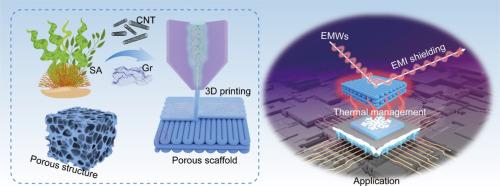3d打印海藻酸钠/碳纳米管/石墨烯多孔支架与Ca2+交联用于高性能电磁屏蔽和焦耳加热。
IF 12.5
1区 化学
Q1 CHEMISTRY, APPLIED
引用次数: 0
摘要
高性能绿色功能材料已经引起了人们对电磁干扰(EMI)屏蔽应用的极大兴趣,但是创建定制的、低密度、高强度和高效率的生物质屏蔽材料仍然具有挑战性。在本研究中,通过直接墨水书写(DIW) 3D打印,制备了轻质钙+掺杂海藻酸钠(SA)多孔支架,并具有碳纳米管(CNT)/石墨烯(Gr)混合导电网络。制备了具有独特流变性能的SA/CNT/Gr油墨,并可在其基础上自由构建具有任意定制结构的体系结构。Ca2+的掺入促进了分层交联网络的构建,这使得SA/CNT/Gr/Ca2+多孔支架具有提高的抗压强度(增加136%),优异的化学稳定性(在酸性和碱性环境中保持完整性长达30天)和增强的电导率(131.3 S/m)。得益于多孔结构和强大的导电网络,多孔支架在x波段的电磁干扰屏蔽效能(SE)为54.8 dB,比屏蔽效能(SSE)为322.35 dB·cm3·g-1。此外,多孔支架还表现出独特的焦耳加热性能,在低电压(≤3 V)下,其表面稳态温度达到124.6°C,表明其在集成系统中的热管理潜力巨大。本文章由计算机程序翻译,如有差异,请以英文原文为准。

3D-printed sodium alginate/carbon nanotube/graphene porous scaffolds crosslinked with Ca2+ for high-performance electromagnetic shielding and Joule heating
High-performance green functional materials have garnered significant interest for electromagnetic interference (EMI) shielding applications, but creating customized, low-density, high-strength and high-efficiency biomass-based shielding materials remains challenging. In this study, lightweight Ca2+ doped sodium alginate (SA) porous scaffolds with a carbon nanotube (CNT)/graphene (Gr) hybrid conductive network were fabricated via direct ink writing (DIW) 3D printing. The SA/CNT/Gr inks with unique rheological properties were formulated and architectures with arbitrarily customized structures could be freely constructed based on the printable inks. The incorporation of Ca2+ facilitated the construction of hierarchical crosslinking networks, which imparted the SA/CNT/Gr/Ca2+ porous scaffolds with improved compressive strength (a 136 % increase), excellent chemical stability (maintaining integrity in both acidic and alkaline environments for up to 30 days) and enhanced electrical conductivity (131.3 S/m). Benefiting from their porous structure and robust conductive network, the porous scaffolds achieved an admirable EMI shielding effectiveness (SE) of 54.8 dB and a high specific shielding effectiveness (SSE) of 322.35 dB·cm3·g−1 in the X-band. Furthermore, the porous scaffolds also exhibited distinctive Joule heating performance, and their surface steady-state temperature reached 124.6 °C under a low applied voltage (≤ 3 V), indicating great potential for thermal management in integrated systems.
求助全文
通过发布文献求助,成功后即可免费获取论文全文。
去求助
来源期刊

Carbohydrate Polymers
化学-高分子科学
CiteScore
22.40
自引率
8.00%
发文量
1286
审稿时长
47 days
期刊介绍:
Carbohydrate Polymers stands as a prominent journal in the glycoscience field, dedicated to exploring and harnessing the potential of polysaccharides with applications spanning bioenergy, bioplastics, biomaterials, biorefining, chemistry, drug delivery, food, health, nanotechnology, packaging, paper, pharmaceuticals, medicine, oil recovery, textiles, tissue engineering, wood, and various aspects of glycoscience.
The journal emphasizes the central role of well-characterized carbohydrate polymers, highlighting their significance as the primary focus rather than a peripheral topic. Each paper must prominently feature at least one named carbohydrate polymer, evident in both citation and title, with a commitment to innovative research that advances scientific knowledge.
 求助内容:
求助内容: 应助结果提醒方式:
应助结果提醒方式:


